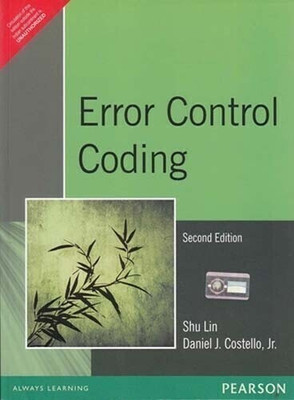Error Control Coding 2 Edition(English, Paperback, Lin Shu Jr.)
Quick Overview
Product Price Comparison
Published in the year 2010, Error Control Coding is a book that throws light on several error control techniques, by using numerous illustrations and solved examples. Summary Of The Book Error Control Coding is ideal for students pursuing beginner courses in digital communications, while it also meets the requirements of advanced programs in information theory. The authors have presented the content in such a manner that it requires minimal mathematical knowledge. However, to comprehend the algebraic coding techniques that are present in the first chapter one it is imperative to have a brief understanding of modern algebra. In total, there are 21 chapters present in this book. Some of them include Introduction To Algebra, Convolutional Codes, Block Coded Modulation, Trellis Coded Modulation, Trellis-Based Decoding Algorithms For Convolutional Coding, and Turbo Coding. Binary BCH Codes, Majority-Logic Decodable Codes, Important Linear Block Codes, Linear Block Codes, and Coding For Reliable Digital Transmission And Storage are a few of the other lessons presented. Other chapters include Nonbinary BCH Codes, Reed-Solomon Codes, and Decoding Algorithms, Automatic-Repeat-Request Strategies, Low Density Parity Check Codes, Code Decomposition, Concatenated Coding, and Multistage Decoding. In Error Control Coding, the base concepts and theories remain the same as in the first edition of the book. Readers are given information on the basics of coding, applications of codes, and the building of real time systems. Additionally, the authors also throw light on the recent advancements in the field that have occurred after the release of the first edition. Readers are also provided with a new set of problems, which have direct application to the concepts outlined. Difficult problems have also been added for advanced students. There are hundreds of examples, along with over 200 illustrations, which make it easier for students to understand the concepts. About The Authors The author of this book, Shu Lin, is a renowned professor of engineering studies. Lin completed his B.S.E.E degree from the National Taiwan University in the year 1959. Following that, he completed his M.S.E.E and doctoral degree from Rice University. Through the course of his career as a professor, Lin has taught at a number of universities. They include the University of Hawaii, South Australian Institute of Technology, Technical University of Munich, and the University of California. His main areas of interest lie in coded modulation, algebraic coding theory, satellite communications, and error control systems. Lin is presently a member of the Electrical And Computer Engineering Graduate Group. Daniel J. Costello is a well-known author and a professor of engineering studies. Costello was born on the 9th of August, 1942, and completed his B.S.E.E. degree in the year 1964, from Seattle University, WA. He later completed his masterŌĆÖs and doctoral degree from the University of Notre Dame. Costello is also a member of the IEEE and was promoted to being a fellow of the institution in the year 1985. His main areas of research interest are coding theory and coding techniques. Costello has also been presented with the Aaron D. Wyner Distinguished Service Award in the year 2013, along with the Communications Society & Information Theory Society Joint Paper Award in 2012.


